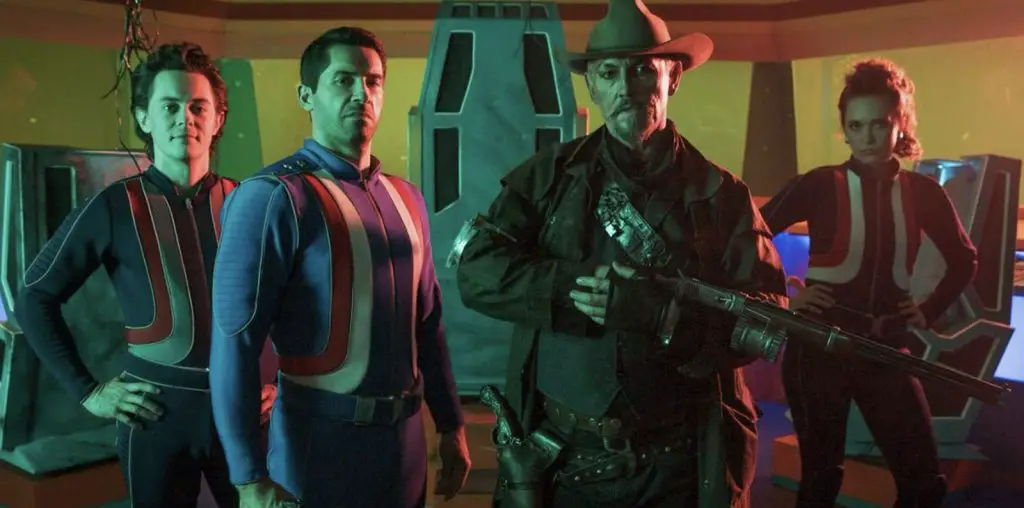
It’s been 20 years since Giorgio Moroder presented his vision of Fritz Lang’s “Metropolis,” yet this production has continued to stir debate ever since. Even though the Moroder version of “Metropolis” has been out of circulation for years, it is still fondly recalled by many film lovers. One fan, in particular, took it upon himself to bring it back on bootleg DVD. But more about him later.
I have a special soft part in my heart for this version, as it was the first time I saw a silent film in a theatrical setting. I believe many people also shared the same experience, which is why so many ordinary movie lovers (as opposed to very serious critics and film scholars) love the Moroder version.
To his credit, Moroder was able to hunt down as much missing “Metropolis” footage as possible, and where the footage was completely lost he used still photographs to fill in the plot gaps. The 1926 Fritz Lang production had suffered from severe editing, first after its less-than-stellar German premiere and then for its 1927 American release. A previous attempt at restoring “Metropolis” was conducted by an East German film archive in the late 1960s, but Moroder took the restoration process further.
Some people, however, felt he took it too far. For starters, Moroder had the film projected at 24fps, giving it a tight 87 minute running time. Previous versions offered the film at a slower 18fps, keeping it at two hours’ running time. Moroder also eliminated all of the intertitles used for the dialogue and instead printed subtitles on the scenes. This was never done during the silent era and often the actors lips are not moving when their dialogue is superimposed at the bottom of the screen.
Martin Koerber, who helmed the 2002 restoration of “Metropolis,” explained more of Moroder’s actions. “Moroder took the advice of Enno Patalas, then director of the Munich Filmmuseum and the father of the first good philological restoration,” said Koerber. “So he re-arranged the existing footage according to Lang’s script, and even re-created some of the missing scenes with the help of stills, but on the other hand he edited a lot of scenes out to make the film faster and slicker. So his version is HIS VERSION, which is perfectly legitimate as long as it is called that, but it is not a restoration in my opinion.”
Koerber also found displeasure with Moroder’s uses of tinting the footage, rather than presenting it in black and white. “The tinting is perfectly arbitrary and follows his tastes,” he says. “I don’t believe the original version was ever tinted. There are some tinted original prints around, but they are all different in color depending on where they were found, and they are all printed from the export neg. That leads me to believe the film was produced and exported in black and white and tinted locally whenever a distributor thought it should be tinted. Even if it would have been tinted, we have no record of what the tints may have been, so we left it alone and show it in beautiful black and white.”
I hate to contradict Koerber, since he is the expert on the film, but I believe Moroder’s tinted effects were more effective (I’ve seen both versions in theatrical presentations). Moroder’s use of icy blue tints when showing the workers’ powering the underground machines and the delirious red for Freder’s hallucinations (when the malfunctioning machine turns into a monster or when the Seven Deadly Sins come to life) heighten the power of Lang’s vision much more effectively than a standard monochrome presentation.
Then, of course, there is the music. Moroder created a new score for the film, and while it was mostly an instrumental creation (most of it being effective) there were pauses for pop tunes crooned by the likes of Pat Benatar, Freddie Mercury, Bonnie Tyler and Loverboy (which I have to admit didn’t always seem like a good idea). Even in 1984, there was a great deal of harrumphing over this rock intrusion. Moroder realized the debate he would be stirring and inserted a quote from Fritz Lang at the beginning of the film that seemed to both justify and apologize for his musical attachment: “To begin with, I should say that I am a visual person. I experience with my eyes and never, or only rarely, with me ears – to my constant regret.”
Feelings about the Moroder score can still raise emotions, even among the strongest critic. David Cornelius, editor of the Amazing Colossal Web Site, grooves to the Moroder beat. “As for the music, well, I kinda like it – but then, I have a thing for pretentious prog rock, so perhaps my judgment is not the best,” he says. “The score comes and goes, occasionally fitting quite well with the visuals, even adding a nifty ‘jolt’ from a well-timed sting. And that disco number that plays over the Maria striptease scene? Faaaaabulous. The songs range from quite good (I dug that Jon Anderson tune, even if he does sound like Carly Simon) to quite cheesy (Loverboy, ladies and gentlemen!), but overall, nice stuff.”
Cornelius rewatched the film for this article and acknowledged something he had not considered before. “I remembered the movie seeming like an extended music video, but in revisiting, I was surprised to see how poorly the songs fit the visuals,” he add. “Little effort is made on Moroder’s part to mesh the sound and picture when the pop songs are concerned (even going so far as to fade the songs out in awkward places). And the repetition of a few numbers suggested that Moroder just ran out of tunes. I can’t believe he was going for ‘themes’ here.”
South African critic James O’Ehley, who reviewed “Metropolis” for the Sci-Fi Movie Page, was less cordial about the score: “The music is rubbish,” he states, but he quickly notes that even with the wonky score, Moroder accomplished something that no one else had previously done.
“This version actually gave many people who wouldn’t have ordinarily have seen it a chance to see it,” he notes. “I saw the Moroder version at a film festival in South Africa all those many years ago and I remember the one Freddie Mercury song video playing on South African TV too – so it did its bit to keep the movie in the popular collective cultural consciousness back then. Ordinarily you won’t find any silent movies either at film fests or the videoshelves here. Also, watching a silent movie from that era is difficult for most modern mainstream audiences, unless it’s a slapstick short, and while re-editing it like that may seem like heresy, but who is to say that Lang wouldn’t have edited it like that if he were alive today?”
And yet a third opinion can be found from Rick Curnutte, editor of The Film Journal. “I think that the Moroder ‘restoration’ pretty much destroys Lang’s original vision,” he says. “The various tintings and the removal of title cards, rob the film of its immediacy. The decision to speed up the frame rate cuts the film down into an abruptly truncated running time. The music is quite effecting, but overall, Moroder’s version will always be, for me, a failed exercise.”
Whether you love it, hate it, or love it and hate it, the Moroder “Metropolis” is not up for an official second chance. Moroder’s license to the material expired and was not renewed. Martin Koerber’s award-winning restoration, released in the U.S. by Kino International, is now the only official version of “Metropolis” in circulation. Rumors had spread that the Moroder version would be included on the Kino DVD release of the Koerber work, but that did not happen.
Some fans of the Moroder version have created an Internet petition to get the film on DVD. One fan has actually put the film on DVD, using its late-80s laserdisc release as his source material. This version is a blatant bootleg, albeit a good looking one, and a quick hunt around eBay can bring up this copy very easily. It is selling at $11, which is a fair price. As no plans exist to release the Moroder version on DVD, this may be the only way for “Metropolis” fans to enjoy this version on DVD. And with luck, the emergence of bootleg DVDs can help spur a long-overdue official DVD version of the Moroder production.
____________________________________________________________
IMPORTANT NOTICE: The unauthorized duplication and distribution of copyright-protected material is not widely appreciated by the entertainment industry, and on occasion law enforcement personnel help boost their arrest quotas by collaring cheery cinephiles engaged in such activities. So if you are going to copy and sell bootleg videos, a word to the wise: don’t get caught. The purchase and ownership of bootleg videos, however, is perfectly legal and we think that’s just peachy! This column was brought to you by Phil Hall, a contributing editor at Film Threat and the man who knows where to get the good stuff…on video, that is.
Discuss The Bootleg Files in Back Talk>>>


I has such a hard time watching this version. I loved that they restored the film in 2008, but I had a hard time with that too. Granted, the restored version is the best– I feel my version is so much better then the Giorgio Moroder cut. What do you think?
http://www.youtube.com/watch?v=-ouQwGPw_S4